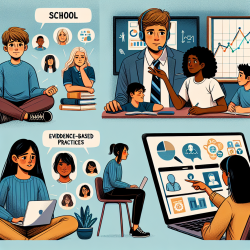Introduction
The COVID-19 pandemic has necessitated a shift in how training and technical assistance (TA) are delivered to the school mental health workforce. The research article, "What Happens When Training Goes Virtual? Adapting Training and Technical Assistance for the School Mental Health Workforce in Response to COVID-19," provides valuable insights into this transition. This blog explores how practitioners can leverage these findings to enhance their skills and outcomes in school mental health.
The Transition to Virtual Training
According to the research, the transition to virtual training has expanded the reach and diversity of the audience without compromising trainee satisfaction or perceived impact. This shift has allowed training to reach more remote areas and professionals with limited travel budgets, thus removing traditional barriers to access. Practitioners can capitalize on these findings by embracing virtual training opportunities to broaden their knowledge and skills.
Key Findings and Implications
The study highlights several key outcomes from the transition to virtual training:
- Increased Reach: Virtual formats have significantly increased participation rates, allowing a broader audience to access training resources.
- Diverse Audience: The shift has attracted a more diverse group of participants, including more representatives from non-White racial groups and those with varying levels of education.
- Maintained Quality: Despite the change in format, the quality of training and TA has remained high, with participants reporting increased mastery of content.
- Direct Family Engagement: Training directly targeting families and caregivers has shown positive impacts on knowledge and behaviors, particularly in suicide prevention.
Practitioners can use these insights to advocate for continued investment in virtual training platforms and to explore new ways to engage with diverse communities and family members in mental health support.
Encouraging Further Research
While the findings are promising, the study also highlights areas for further exploration. Practitioners are encouraged to engage in ongoing research to better understand the long-term impacts of virtual training on implementation processes and outcomes. Additionally, exploring ways to overcome challenges related to technology access and engagement in virtual settings will be crucial.
Conclusion
The shift to virtual training has demonstrated significant benefits for the school mental health workforce, offering increased access, diversity, and engagement. By embracing these changes and continuing to explore innovative approaches, practitioners can enhance their skills and improve outcomes for students. To read the original research paper, please follow this link: What Happens When Training Goes Virtual? Adapting Training and Technical Assistance for the School Mental Health Workforce in Response to COVID-19.










